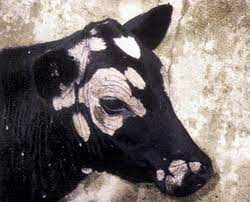Dermatophytosis or Ring worm infestation in Livestock
Dermatophytosis is an contagious disease of keratinized tissue (skin, hair, and claws) by one of the three genera of fungi collectively called dermatophytes—Epidermophyton, Microsporum, and Trichophyton. Epidermophyton occurs only in human being. Microsporum, and Trichophyton.occur in cattle, sheep & goat, horse, pig, dog & cat.
Transmission: Transmission occur by direct conduct of the affected animal and indirect contact occurs if skin is abraded or bruised by grooming implements following grooming of affected animal. Ringwors attack the keratinized tissue particularly the stratum corneum and hair fibres.
Zoonotic implications: Human are frequently infected with ringworm fungi of animal origin through direct contact with infected animal, their bedding, hair clipping, cages etc.
Clinical Signs:
Cattle- In cattle, generalized lesions may occur throughout the body surface in calves; in cow and heifer occur in chest and in bulls dewlap and intermaxillary space. The lesions are – dicrete, roughly circular about 3-4 cm in diameter, raised above the skin. Scaling patches of hair loss with grey-white crust but with no itching; suppuration may occur.
Dog and Cat: Ringworm in dogs is caused mainly by Microsporum canis (70% of cases), but also by M gypseum (20%) and Trichophyton mentagrophytes (10%); in cats, 98% are caused by M canis. The clinical appearance of ringworm in cats is quite variable. Kittens are affected most commonly. Typical lesions consist of focal alopecia, scaling, and crusting; most are located around the ears and face or on the extremities. Lesions in dogs are classically alopecic, scaly patches with broken hairs.
Prominent Symptoms of Dermatophytosis in dogs include:
⦁ Round raised areas of hair loss, irregular patches of hair loss.
⦁ Scaly or crusty skin irritated and inflamed hair follicles.
⦁ Pustules on the skin.
⦁ Dry, brittle or cracked nails.
⦁ Secondary bacterial skin infections.
All three are zoonotic and may be transmitted from pet to human. Microsporum canis – fungus that affects the upper layers of the skin on cat, dog and human.
Pig: Dermatophytosis in pigs is usually caused by Microsporum nanum. Lesions are rings of inflammation or brown discoloration that spread centrifugally up to a diameter of 6 cm.
Horse: Trichophyton equinum and T mentagrophytes are the primary cause of ringworm in horses, although Microsporum gypseum, M canis, and T verrucosum have also been isolated. Clinical signs consist of one or more patches of alopecia and erythema, scaling, and crusting, which are present to varying degrees. Lesions progress with crusting and hair loss within a few days.
Sheep and goat: Lesions are found only on head; discrete, round and bald patches covered with grayish crust. In goat- also lesions are same but distributed all over the body.
Diagnosis:
i) Fungal culture– most accurate method of diagnosis. An area of 0.3cm is sterilized around a lesion with alcohol swab, make the area dry and skin scales along with hair is collected and inoculated in DTM (Dermatophyte Test Media).In +ve case the media will become red in colour.
ii) Skin scrapping from periphery of the lesion is to be collected by a scalpel blade, dissolve in 20% KOH solution, prepare slide and examine under microscope.
Treatment:
Although the disease may be self-limiting but cleaning the affected area with potassium hydroxide solutiuon and topical applications with Spray/Washes (like 0.5% hypochlorite solution / 0.5% Chlorhexidine/ 1%Povidone-iodine / Iodophore) or application of Ointments (like Whitefield ointment/ Ammoniated mercury solution/ Propionic and undecyclenic oint/ Neomycin oint/ Thiabendazole oint) or use of Lotions like Immidazole/ Miconazole/ Clotrimazole lotion) are effective.
Compiled & Shared by- This paper is a compilation of groupwork provided by the Team, LITD (Livestock Institute of Training & Development)
Image-Courtesy-Google
Reference-On Request


